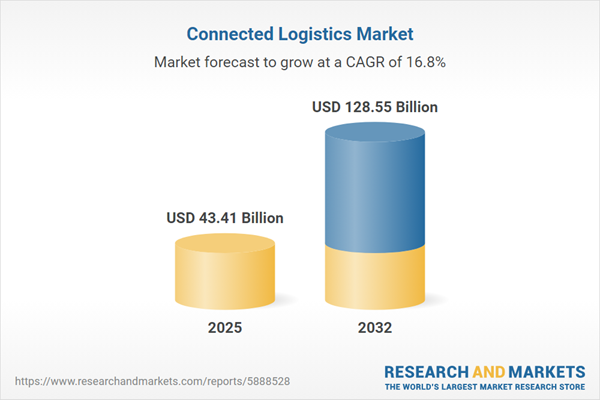Speak directly to the analyst to clarify any post sales queries you may have.
Connected logistics is at the forefront of transforming supply chain performance, offering organizations the ability to enhance transparency, adaptability, and automation in increasingly dynamic global markets. This report presents strategic insights into the evolving landscape of connected logistics, tailored for senior decision-makers seeking operational excellence and resilience.
Market Snapshot: Connected Logistics Market Growth and Opportunities
The Connected Logistics Market grew from USD 37.22 billion in 2024 to USD 43.41 billion in 2025. It is expected to continue growing at a CAGR of 16.75%, reaching USD 128.55 billion by 2032. Strong expansion is underpinned by rapid digital adoption, increased e-commerce activity, and heightened regulatory focus on sustainability. Investments in IoT, AI-driven analytics, and advanced cloud platforms are redefining the value chain for industry stakeholders, as companies pursue real-time data integration and process agility.
Scope & Segmentation of Connected Logistics
This report analyzes the global connected logistics ecosystem across a comprehensive range of segments, technologies, and geographies:
- Logistics Type: Transportation, Warehousing, Private Warehouse, Public Warehouse, Automated Warehouse, Traditional Warehouse
- Mode of Transport: Air, Rail, Road, Sea
- Service Type: Freight Forwarding, Inventory Management, Last Mile Delivery, B2B Delivery, B2C Delivery
- End Use: E-Commerce, Healthcare, Manufacturing, Retail
- Regions Covered: Americas (including United States, Canada, Mexico, Brazil, Argentina, Chile, Colombia, Peru), Europe, Middle East & Africa (including United Kingdom, Germany, France, Russia, Italy, Spain, Netherlands, Sweden, Poland, Switzerland, United Arab Emirates, Saudi Arabia, Qatar, Turkey, Israel, South Africa, Nigeria, Egypt, Kenya), Asia-Pacific (including China, India, Japan, Australia, South Korea, Indonesia, Thailand, Malaysia, Singapore, Taiwan)
- Technologies Profiled: IoT devices, edge computing, AI, machine learning, digital twins, blockchain, cloud-based platforms
- Key Companies Analyzed: FourKites, Inc., project44, Inc., Descartes Systems Group Inc., Transporeon Group GmbH, Oracle Corporation, SAP SE, E2open, LLC, Manhattan Associates, Inc., WiseTech Global Limited, MercuryGate International, Inc.
Key Takeaways for Decision-Makers
- End-to-end connectivity is enabling logistics providers to track assets in real time, anticipate disruptions, and automate routine processes, driving efficiency and asset utilization.
- Technological convergence, including artificial intelligence and digital twins, is reshaping traditional logistics by supporting predictive maintenance, dynamic route optimization, and more agile collaboration across supply chain stakeholders.
- Growing demand for transparency and sustainability is spurring the adoption of emissions tracking, green warehousing, and low-emission vehicles, with technology partnerships central to decarbonization strategies.
- Collaborative ventures between carriers and digital platform specialists are breaking down logistics silos, fostering interoperability, and enabling seamless multi-modal transport experiences.
- Nearshoring and infrastructure investment are emerging as resilience tactics, with regional strategies adapted to local market maturity, regulatory conditions, and infrastructure capabilities.
- Leading market players are enhancing their competitive position through technology integration, strategic acquisitions, and by developing solutions that address both environmental accountability and advanced digitalization.
Tariff Impact and Evolving Trade Dynamics
Recent changes in global tariff regimes have increased complexity in logistics cost structures and supplier strategies. Many organizations are altering transport modalities and favoring regional or near-market sourcing to reduce exposure to trade policy shifts. The trend toward adopting digital customs compliance solutions, scenario modeling, and blockchain-based documentation is helping supply chains remain flexible and cost-efficient amid shifting trade landscapes.
Methodology & Data Sources
This report utilizes a combination of in-depth executive interviews, structured industry surveys, and analysis of secondary sources including regulatory filings and industry publications. Data triangulation and expert peer review have been applied to ensure accuracy in market segmentation, technology impact assessment, and strategic recommendations.
Why This Report Matters
- Supports strategic investment decisions by providing comprehensive analysis of technology adoption, regional dynamics, and service differentiation within connected logistics.
- Enables risk mitigation and opportunity identification through insights into the latest innovations, regulatory trends, and market partnership models.
The report is an essential tool for logistics executives seeking to enhance competitiveness and align with evolving market expectations.
Conclusion
Connected logistics is redefining how organizations achieve supply chain visibility, resilience, and agility. Adopting data-driven technologies and collaborative strategies will be vital for leading logistics players navigating this rapidly evolving market landscape.
Additional Product Information:
- Purchase of this report includes 1 year online access with quarterly updates.
- This report can be updated on request. Please contact our Customer Experience team using the Ask a Question widget on our website.
Table of Contents
3. Executive Summary
4. Market Overview
7. Cumulative Impact of Artificial Intelligence 2025
Companies Mentioned
The companies profiled in this Connected Logistics market report include:- FourKites, Inc.
- project44, Inc.
- Descartés Systems Group Inc.
- Transporeon Group GmbH
- Oracle Corporation
- SAP SE
- E2open, LLC
- Manhattan Associates, Inc.
- WiseTech Global Limited
- MercuryGate International, Inc.
Table Information
| Report Attribute | Details |
|---|---|
| No. of Pages | 183 |
| Published | October 2025 |
| Forecast Period | 2025 - 2032 |
| Estimated Market Value ( USD | $ 43.41 Billion |
| Forecasted Market Value ( USD | $ 128.55 Billion |
| Compound Annual Growth Rate | 16.7% |
| Regions Covered | Global |
| No. of Companies Mentioned | 11 |









